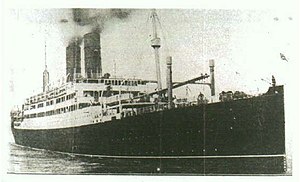| SS Tuscania (1914) | |
|---|---|
 SS Tuscania (1914) | |
| Career | Anchor Line |
| Builder: | Alexander Stephen & Sons, Ltd., Linthouse, Govan |
| Laid down: | 1914 |
| Launched: | September 1914 |
| Fate: | Sunk 5 February 1918 |
| General characteristics | |
| Tonnage: | 14,348 gross tons |
| Length: | 567 ft (173 m) |
| Beam: | 66 ft 4 in (20.22 m) |
| Draught: | 45 ft (14 m) |
| Propulsion: | Parsons steam turbines - twin screw [1] |
| Capacity: | 2,500+ passengers |
| Armament: | 4-inch naval gun (fitted October 1916) [2] |
The SS Tuscania was a luxury liner of the Cunard subsidiary Anchor Line, named after a town in Italy. She was torpedoed in 1918 by the German U-boat UB-77 while carrying American troops to Europe and sank with a loss of 210 lives.[3]
Commercial career[]
The Tuscania carried passengers between New York City and Glasgow while in service with the Anchor Line, on a route that had previously been assigned to her sistership Transylvania.[1] She continued to run this route even as World War I broke out in Europe and Germany initiated. She also made at least one run from Bombay to Liverpool. Unrestricted submarine warfare in British territorial waters put neutral ships like the Tuscania at risk of being misidentified and attacked. The Tuscania made international headlines for rescuing passengers and crew from the burning Greek steamer SS Athinai on September 20, 1915,[4] and made the news again in March 1917 by evading a submarine and a suspected German commerce raider.[5]
Final voyage[]
On the morning of February 5, 1918, carrying over 2,000 American troops, the HMS Tuscania turned south for the North Channel en route to Liverpool. After an arduous voyage across the North Atlantic, most of those aboard, in sight of the Irish coast to starboard and the Scottish coast to port, surely believed the worst part of their journey was behind them. Spotted by German submarine UB-77 earlier in the day, however, their convoy was stalked until early evening and the cover of darkness. Then, at about 6:40 pm, submarine captain Lt. Cdr. Wilhelm Meyer ordered two torpedoes fired at the Tuscania. The second of these struck home, sending her—within about four hours—to the bottom of the Channel.
It was on February 6, 1915, almost exactly three years before the fatal day, that Tuscania had made her maiden voyage as a passenger liner serving the North Atlantic routes between New York and Great Britain. In 1916, though, she had been refitted and pressed into service as a troop carrier, and on her final voyage she had departed Hoboken, New Jersey 12 days earlier with 384 crew members and 2,013 American troops aboard. Approximately 210 of the troops and crew were lost,[3] while many others were rescued by two British destroyers, the HMS Mosquito and HMS Pigeon.[6]
Today she lies between Scotland's Islay Isle and Ireland's Rathlin Island, about 7 miles north of Rathlin lighthouse, at roughly N 55.41, W 6.185, under 100 meters of sea.
Notable passengers[]
- Harry Randall Truman, who later died in the 1980 eruption of Mount St. Helens
- Sydney Brooks, British critic (survived sinking)[7][8]
- Leonard Read, founder of Foundation for Economic Education (survived sinking)
- Valentine Grant, silent film actress (survived sinking)
Army units on board[]
- 100th Aero Squadron
- 158th Aero Squadron
- 213th Aero Squadron
- 32nd Infantry Division (United States)
- 20th Engineers
- 357th Infantry
- 165th Depot
References[]
- ↑ 1.0 1.1 "Tuscania Was Pride of the Anchor Line" New York Times 07 Feb 1918: p. 2
- ↑ "Tuscania Carried No Civil Passengers" New York Times 07 Feb 1918: p. 2
- ↑ 3.0 3.1 Massie, Robert K. Castles of Steel: Britain, Germany, and the Winning of the Great War at Sea. New York: Ballantine Books, 2004. ISBN 0-345-40878-0
- ↑ "Greek Liner Burns at Sea, 469 saved" The Philadelphia Inquirer, September 21, 1915: p.2
- ↑ "Report the Tuscania Dodged a Submarine" The New York Times 22 Mar 1917: p.3
- ↑ "Troopship Tuscania Oa Peninsula Islay|Loss of Troopship Tuscania". Islayinfo.com. http://www.islayinfo.com/loss-troopship-tuscania-islay.html. Retrieved 2012-12-14.
- ↑ "Sydney Brooks - Wikisource, the free online library". En.wikisource.org. http://en.wikisource.org/wiki/Author:Sydney_Brooks. Retrieved 2012-12-14.
- ↑ "Britain's Heart Now of Granite" The New York Times, January 19, 1916: p.2
External links[]
- Tuscania, an American History
- 100th Aero Squadron - History(subscription required)
- 158th Aero Squadron - History(subscription required)
- 213th Aero Squadron - History(subscription required)
Coordinates: 55°37′N 6°26′W / 55.617°N 6.433°W
The original article can be found at SS Tuscania (1914) and the edit history here.